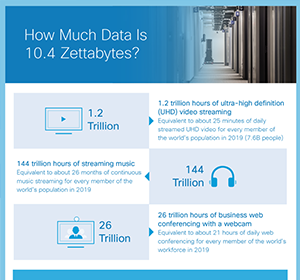In October 2015, Cisco released its updated Global Cloud Index (GCI) report for 2014 – 2019. Highlights from the updated research include the following projections:
- Global datacentre traffic will grow nearly 3-fold
- By 2019, global datacentre traffic will reach 10.4 Zettabytes per year
- By 2019, 83 percent of all datacentre traffic will come from the cloud
- By 2019, 4 out of 5 datacentre workloads will be processed in the cloud
Several factors are driving cloud traffic’s accelerating growth and the transition to cloud services, including the personal cloud demands of an increasing number of mobile devices; the rapid growth in popularity of public cloud services for business, and the increased degree of virtualisation in private clouds which is increasing the density of those workloads.
“The Global Cloud Index highlights the fact that cloud is moving well beyond a regional trend to becoming a mainstream solution globally, with cloud traffic expected to grow more than 30 percent in every worldwide region over the next five years,” said Doug Webster, vice president of service provider marketing, Cisco.
“Enterprise and government organisations are moving from test cloud environments to trusting clouds with their mission-critical workloads. At the same time, consumers continue to expect on-demand, anytime access to their content and services nearly everywhere. This creates a tremendous opportunity for cloud operators, which will play an increasingly relevant role in the communications industry ecosystem.”
In addition to the rapid growth of cloud traffic, Cisco predicts that the Internet of Everything (IoE)—the connection of people, processes, data and things—could have a significant impact on datacentre and cloud traffic growth. A broad range of IoE applications are generating large volumes of data that could reach 507.5 ZB per year (42.3 ZB per month) by 2019. That’s 49 times greater than the projected datacentre traffic for 2019 (10.4 ZB). Today, only a small portion of this content is stored in datacentres, but that could change as the application demand and uses of big data analytics evolves (i.e., analysing collected data to make tactical and strategic decisions).
Additional key data reported included:
Datacentre virtualisation
- Overall datacentre workloads will more than double from 2014 to 2019; however, cloud workloads will more than triple over the same period.
- The workload density (that is, workloads per physical server) for cloud datacentres was 5.1 in 2014 and will grow to 8.4 by 2019. Comparatively, for traditional datacentres, workload density was 2.0 in 2014 and will grow to 3.2 by 2019.
Cloud-based datacentres
- Around 86 percent of all workloads will be cloud-based by 2019.
- Cloud workloads are growing rapidly (27 percent CAGR) while traditional datacentre workloads are declining (-0.7 percent CAGR).
Private vs. Public Cloud Growth
Public cloud, in which services are rendered over a network that is open for public use, is growing faster than private cloud, which includes cloud infrastructure operated for a single organisation, in terms of workloads. However, throughout the five-year forecast, private cloud will continue to outpace public cloud in its degree of virtualisation. With businesses increasingly assessing the cost associated with IT dedicated resources and demanding for more agility, public cloud adoption will rise. The Cisco Cloud Index projects:
- Public cloud workloads are going to grow at a 44-percent Compound Annual Growth Rate (CAGR) from 2014 to 2019 and private cloud workloads will grow at a slower pace (16-percent CAGR) from 2014 to 2019.
- By 2019, 56 percent of the cloud workloads will be in public cloud datacentres, up from 30 percent in 2014. (CAGR of 44 percent from 2014 to 2019.)
- By 2019, 44 percent of the cloud workloads will be in private cloud datacentres, down from 70 percent in 2014. (CAGR of 16 percent from 2014 to 2019.)
Global Cloud Workloads
SaaS will be the most popular and adopted service model for public and private cloud workloads, respectively, by 2019.
- By 2019, 59 percent of the total cloud workloads will be Software-as-a-Service (SaaS) workloads, up from 45 percent in 2014.
- By 2019, 30 percent of the total cloud workloads will be Infrastructure-as-a-Service (IaaS) workloads, down from 42 percent in 2014.
- By 2019, 11 percent of the total cloud workloads will be Platform-as-a-Service (PaaS) workloads, down from 13 percent in 2014.
Additional information
Visit Cisco to learn more of the new GCI report.
Download the Cisco Infographic (8.9Mb PDF) ![]()


